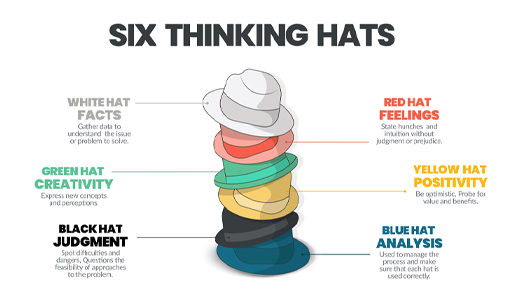2.2 How to use the 6 thinking hats
By ‘wearing’ each of the 6 Thinking Hats in turn, you can gain a better understanding of the issues you face – and the best ways forward. Each hat gives you a different perspective for thinking about a problem, and it also helps you to understand how other people might think about the situation too.
When using the 6 hats technique, try using the blue hat first and last. This hat is about thinking about the bigger picture and how you are going to solve it. You can decide the main question you want to answer and the order in which to put on the other hats.
Let’s take the decision on whether or not to use street protests and rioting as a way to get your voice heard.
Blue hat: Wear the blue hat to frame your question. For example: ‘Is rioting the best way for us as young people to get our voice heard?’ ‘What information do I need?’ ‘Whose views do I need to consider?’
For example:
- do you need to consider the facts (white hat)
- what you are feeling (red hat)
- look at potential problems or risks and evaluate (black hat)
- think positively (yellow hat)
- come up with different ideas and solutions (green hat).
If you put the blue hat on again at the end of the exercise, then with this organisational hat on you can pull together all the different perspectives to help you decide what you want to do.
Here are some of the alternative solutions Dylan suggested in his case for what young people could do to get their voice heard, instead of getting involved in the riots.
‘If you want to get your voice heard, go to someone, your local youth group or your mum to try and see if she knows anyone to get your voice heard, you could go to your local politicians or your representatives or if you really wanted you could go down to the Shankill Mirror or into your youth group and say look this here is wrong. This happened and maybe they could help you sort it out before it turns into violence.’

